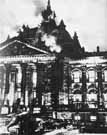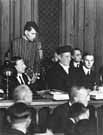
|
|
|

|

|

|

|
|
Click on an image to see a larger, more detailed picture.
|
|
|
|
|
| 1933: The Nazi State Begins |

|
pg. 59 |

|
|
|
|
| |
 As the Reichstag went up in flames on February 27, 1933, the Nazis prepared to move against their primary political opponent, the Communist Party of Germany. Blaming the fire on a Dutch Communist, the Nazis suspended civil liberties on February 28. Thousands of Communists were arrested and hastily sent to the recently opened concentration camps at Dachau, Germany, and other locations.
As the Reichstag went up in flames on February 27, 1933, the Nazis prepared to move against their primary political opponent, the Communist Party of Germany. Blaming the fire on a Dutch Communist, the Nazis suspended civil liberties on February 28. Thousands of Communists were arrested and hastily sent to the recently opened concentration camps at Dachau, Germany, and other locations.
Photo: Bildarchiv Preussischer Kulturbesitz/United States Holocaust Memorial Museum Photo Archive
|
 Members of the German Communist Party (KPD) were arrested and closely guarded following the burning of the Reichstag building in February 1933. Hermann Göring's boast that "whoever raises a hand against us shall lose his head" led to mass arrests and many executions. Not only were political opponents taken into custody, but members of the Nazi Party suspected of being disloyal were also rounded up. Estimates vary greatly regarding the number of summary executions carried out by Nazi Storm Troopers, but thousands of "enemies" disappeared after the imposition of martial law in March.
Members of the German Communist Party (KPD) were arrested and closely guarded following the burning of the Reichstag building in February 1933. Hermann Göring's boast that "whoever raises a hand against us shall lose his head" led to mass arrests and many executions. Not only were political opponents taken into custody, but members of the Nazi Party suspected of being disloyal were also rounded up. Estimates vary greatly regarding the number of summary executions carried out by Nazi Storm Troopers, but thousands of "enemies" disappeared after the imposition of martial law in March.
Photo: UPI/Corbis-Bettmann
|
 The Fire
The Fire
On the night of February 27, 1933, the Reichstag building in Berlin was set on fire. German police arrested a Dutch Communist, Marinus van der Lubbe, whom they discovered at the scene. Hitler interpreted this clear case of arson as the first step of a Communist revolution, and he pushed for the arrest of several German Communist leaders as well as representatives of Communist International. Van der Lubbe, however, was the only one of the accused convicted. Even at the time, many observers believed that the Nazis set the fire themselves, using it as a pretext to crack down on their political enemies. Scholars remain divided on the issue. Some argue that van der Lubbe started the fire and that Hitler was the beneficiary of a remarkable stroke of good luck.
|
|

|

|

|

|
 February 19 and 26, 1933: Father Charles Coughlin, a Jew-hating priest--Canadian but working in the Detroit, Michigan, diocese--sermonizes on the radio that "Shylocks" (Jews) are causing the Depression. He receives 80,000 letters of support a week, about 70 percent from Protestants. His editorials often parallel those of the Nazi press. He is friendly with several U.S. senators and representatives.
February 19 and 26, 1933: Father Charles Coughlin, a Jew-hating priest--Canadian but working in the Detroit, Michigan, diocese--sermonizes on the radio that "Shylocks" (Jews) are causing the Depression. He receives 80,000 letters of support a week, about 70 percent from Protestants. His editorials often parallel those of the Nazi press. He is friendly with several U.S. senators and representatives.
|
 February 20, 1933: Hitler wins over a group of leading German industrialists at a meeting designed for that purpose.
February 20, 1933: Hitler wins over a group of leading German industrialists at a meeting designed for that purpose.
|
 February 27, 1933: The German Reichstag building is set ablaze. The Nazis are quick to blame the fire on Communists.
February 27, 1933: The German Reichstag building is set ablaze. The Nazis are quick to blame the fire on Communists.
|
 February 28, 1933: A presidential decree gives Chancellor Hitler emergency powers. All 100 Communist Party members of the Reichstag are arrested. One Berlin man is given 50 lashes for being a Communist and 50 more for being a Jew.
February 28, 1933: A presidential decree gives Chancellor Hitler emergency powers. All 100 Communist Party members of the Reichstag are arrested. One Berlin man is given 50 lashes for being a Communist and 50 more for being a Jew.
|
|
|
|
|
| 1933: The Nazi State Begins |

|
pg. 59 |

|
|
The Holocaust Chronicle
© 2009 Publications International, Ltd.
|
|
